Analysis: H&M Brand Image and Customer Purchasing Behavior
VerifiedAdded on 2022/08/25
|13
|3291
|33
Report
AI Summary
This report examines the impact of H&M's brand image on consumer purchasing behavior. It begins with an introduction outlining the background, aims, objectives, and research questions, focusing on the influence of brand image on customer decisions. The literature review explores brand image, brand equity, and brand loyalty, and how these factors affect purchasing behavior in the context of clothing companies. The methodology section details the research philosophy (positivism), approach (deductive), and design (descriptive), along with data collection methods, including primary sources like surveys, sample size, and data analysis techniques. The study aims to identify how H&M's brand image affects customer purchasing decisions, exploring the connection between brand image, brand loyalty, and buying behavior, and identifying factors influencing customer choices regarding apparel. The report concludes with a list of references used in the research.
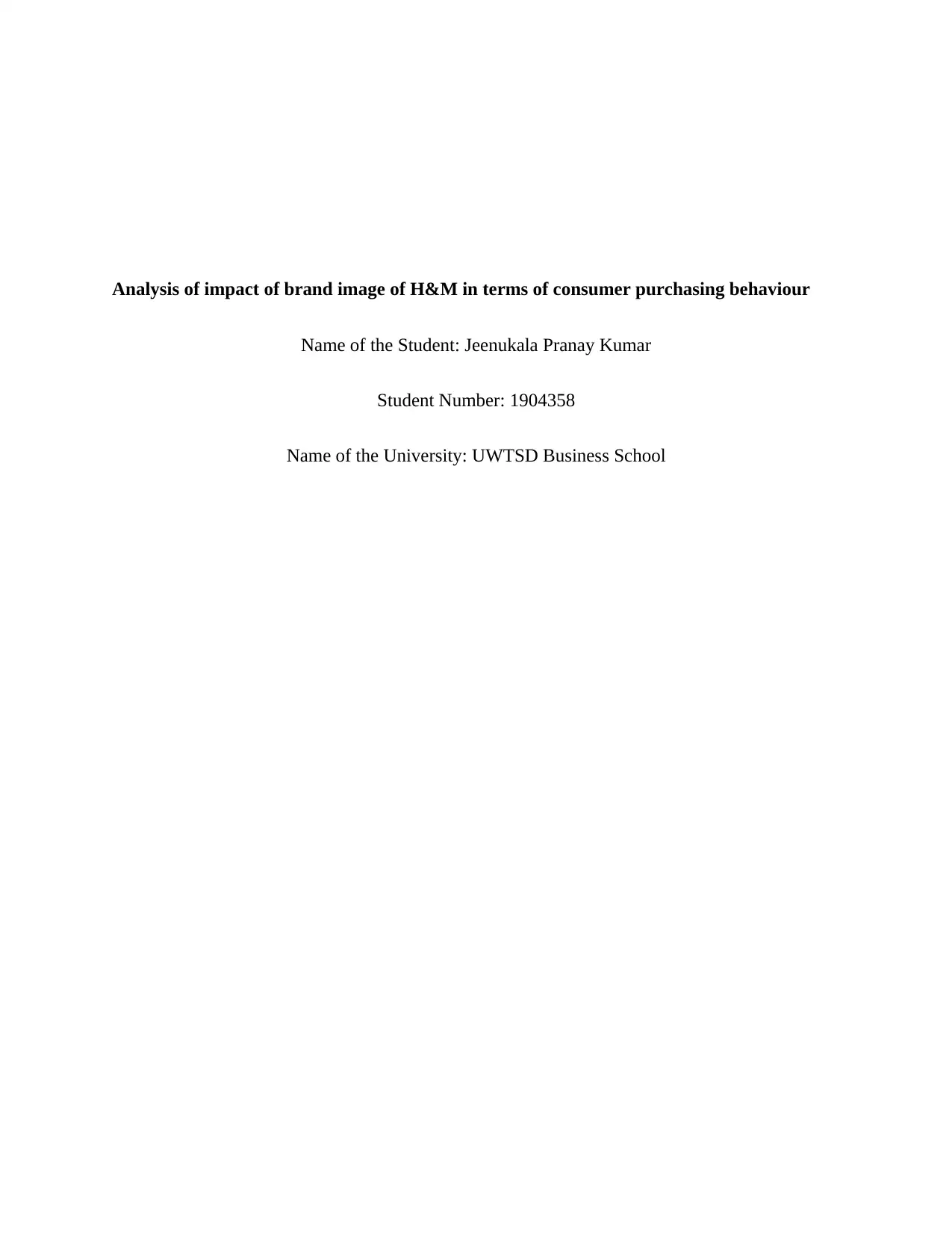
Analysis of impact of brand image of H&M in terms of consumer purchasing behaviour
Name of the Student: Jeenukala Pranay Kumar
Student Number: 1904358
Name of the University: UWTSD Business School
Name of the Student: Jeenukala Pranay Kumar
Student Number: 1904358
Name of the University: UWTSD Business School
Paraphrase This Document
Need a fresh take? Get an instant paraphrase of this document with our AI Paraphraser
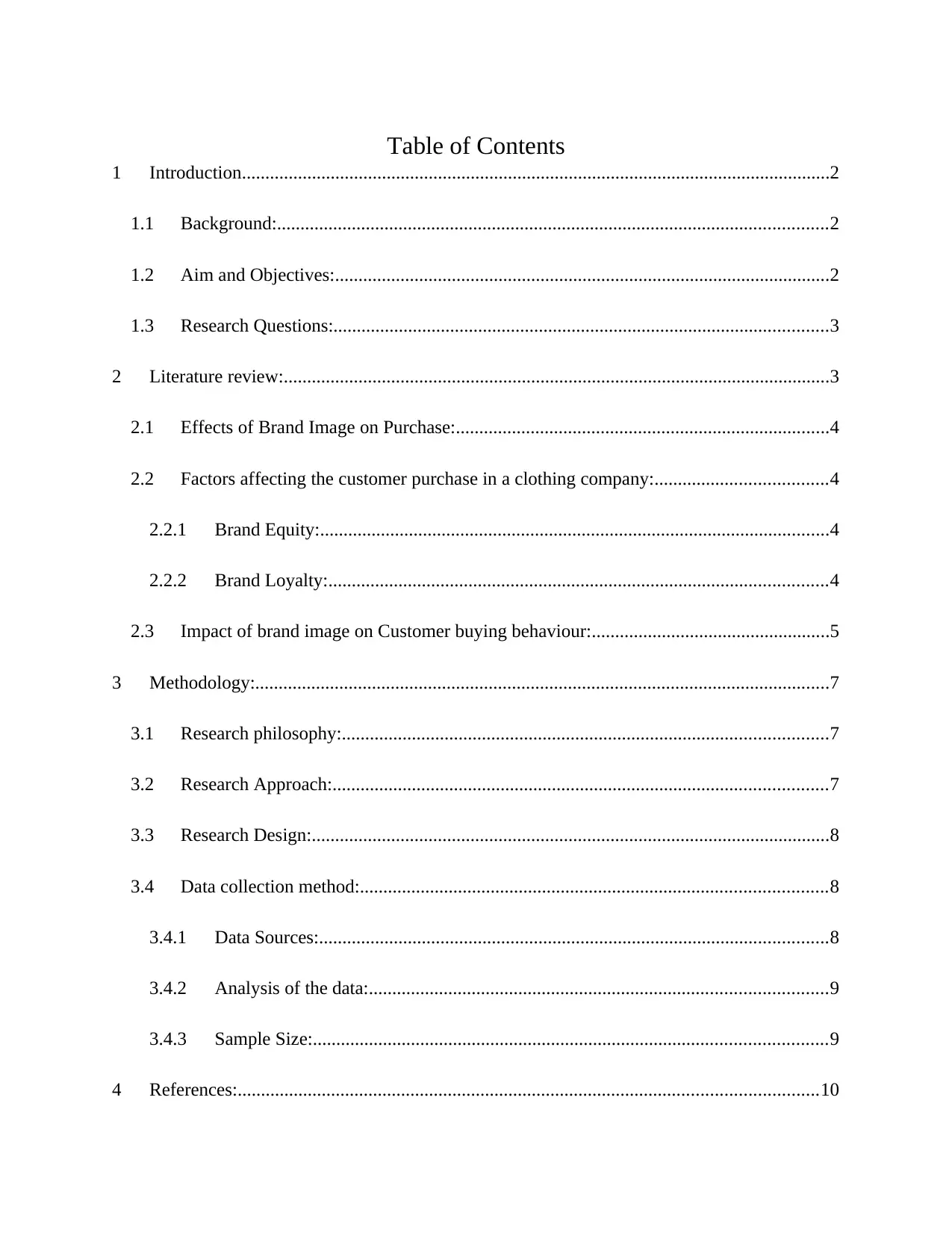
Table of Contents
1 Introduction..............................................................................................................................2
1.1 Background:......................................................................................................................2
1.2 Aim and Objectives:..........................................................................................................2
1.3 Research Questions:..........................................................................................................3
2 Literature review:.....................................................................................................................3
2.1 Effects of Brand Image on Purchase:................................................................................4
2.2 Factors affecting the customer purchase in a clothing company:.....................................4
2.2.1 Brand Equity:.............................................................................................................4
2.2.2 Brand Loyalty:...........................................................................................................4
2.3 Impact of brand image on Customer buying behaviour:...................................................5
3 Methodology:...........................................................................................................................7
3.1 Research philosophy:........................................................................................................7
3.2 Research Approach:..........................................................................................................7
3.3 Research Design:...............................................................................................................8
3.4 Data collection method:....................................................................................................8
3.4.1 Data Sources:.............................................................................................................8
3.4.2 Analysis of the data:..................................................................................................9
3.4.3 Sample Size:..............................................................................................................9
4 References:............................................................................................................................10
1 Introduction..............................................................................................................................2
1.1 Background:......................................................................................................................2
1.2 Aim and Objectives:..........................................................................................................2
1.3 Research Questions:..........................................................................................................3
2 Literature review:.....................................................................................................................3
2.1 Effects of Brand Image on Purchase:................................................................................4
2.2 Factors affecting the customer purchase in a clothing company:.....................................4
2.2.1 Brand Equity:.............................................................................................................4
2.2.2 Brand Loyalty:...........................................................................................................4
2.3 Impact of brand image on Customer buying behaviour:...................................................5
3 Methodology:...........................................................................................................................7
3.1 Research philosophy:........................................................................................................7
3.2 Research Approach:..........................................................................................................7
3.3 Research Design:...............................................................................................................8
3.4 Data collection method:....................................................................................................8
3.4.1 Data Sources:.............................................................................................................8
3.4.2 Analysis of the data:..................................................................................................9
3.4.3 Sample Size:..............................................................................................................9
4 References:............................................................................................................................10
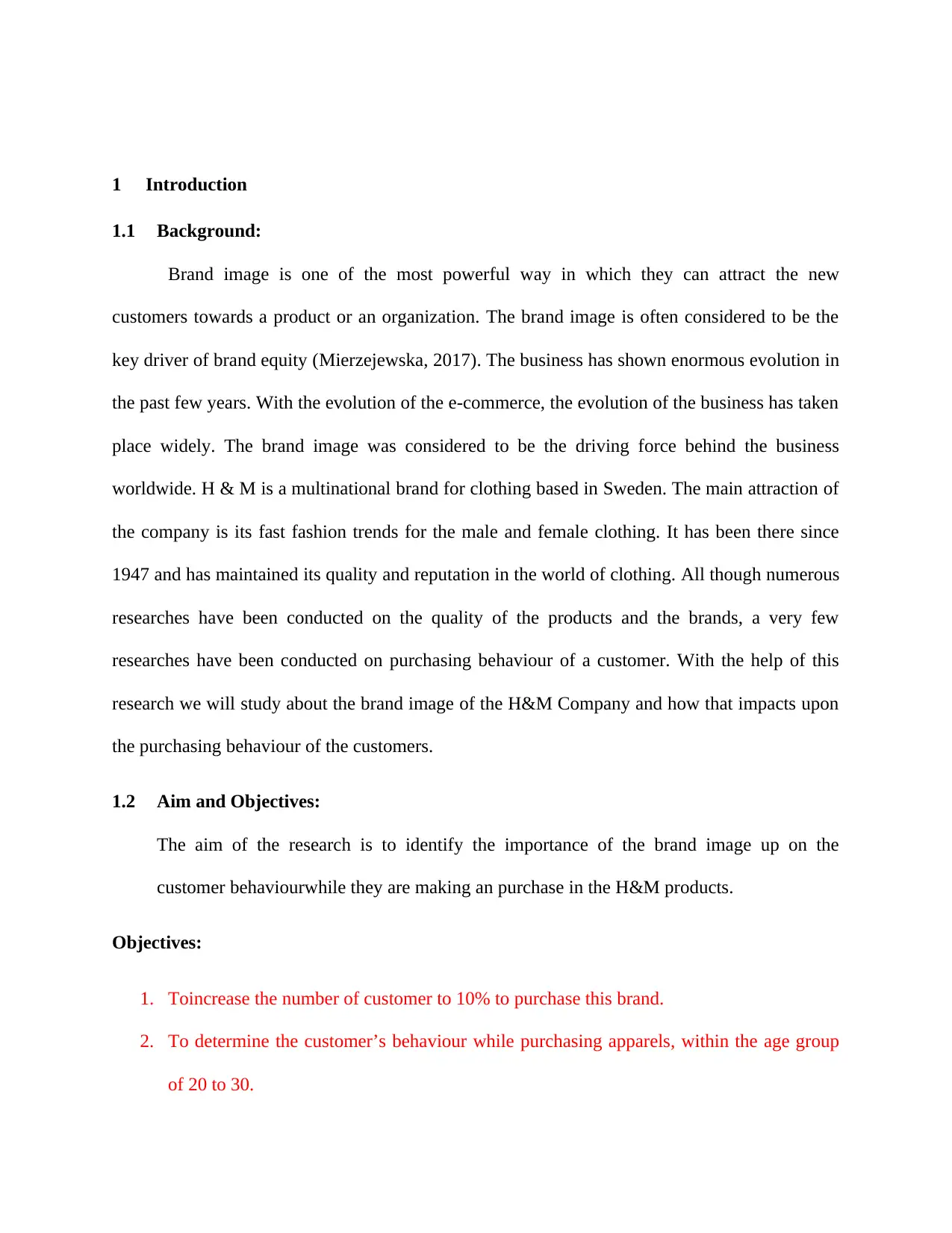
1 Introduction
1.1 Background:
Brand image is one of the most powerful way in which they can attract the new
customers towards a product or an organization. The brand image is often considered to be the
key driver of brand equity (Mierzejewska, 2017). The business has shown enormous evolution in
the past few years. With the evolution of the e-commerce, the evolution of the business has taken
place widely. The brand image was considered to be the driving force behind the business
worldwide. H & M is a multinational brand for clothing based in Sweden. The main attraction of
the company is its fast fashion trends for the male and female clothing. It has been there since
1947 and has maintained its quality and reputation in the world of clothing. All though numerous
researches have been conducted on the quality of the products and the brands, a very few
researches have been conducted on purchasing behaviour of a customer. With the help of this
research we will study about the brand image of the H&M Company and how that impacts upon
the purchasing behaviour of the customers.
1.2 Aim and Objectives:
The aim of the research is to identify the importance of the brand image up on the
customer behaviourwhile they are making an purchase in the H&M products.
Objectives:
1. Toincrease the number of customer to 10% to purchase this brand.
2. To determine the customer’s behaviour while purchasing apparels, within the age group
of 20 to 30.
1.1 Background:
Brand image is one of the most powerful way in which they can attract the new
customers towards a product or an organization. The brand image is often considered to be the
key driver of brand equity (Mierzejewska, 2017). The business has shown enormous evolution in
the past few years. With the evolution of the e-commerce, the evolution of the business has taken
place widely. The brand image was considered to be the driving force behind the business
worldwide. H & M is a multinational brand for clothing based in Sweden. The main attraction of
the company is its fast fashion trends for the male and female clothing. It has been there since
1947 and has maintained its quality and reputation in the world of clothing. All though numerous
researches have been conducted on the quality of the products and the brands, a very few
researches have been conducted on purchasing behaviour of a customer. With the help of this
research we will study about the brand image of the H&M Company and how that impacts upon
the purchasing behaviour of the customers.
1.2 Aim and Objectives:
The aim of the research is to identify the importance of the brand image up on the
customer behaviourwhile they are making an purchase in the H&M products.
Objectives:
1. Toincrease the number of customer to 10% to purchase this brand.
2. To determine the customer’s behaviour while purchasing apparels, within the age group
of 20 to 30.
⊘ This is a preview!⊘
Do you want full access?
Subscribe today to unlock all pages.

Trusted by 1+ million students worldwide
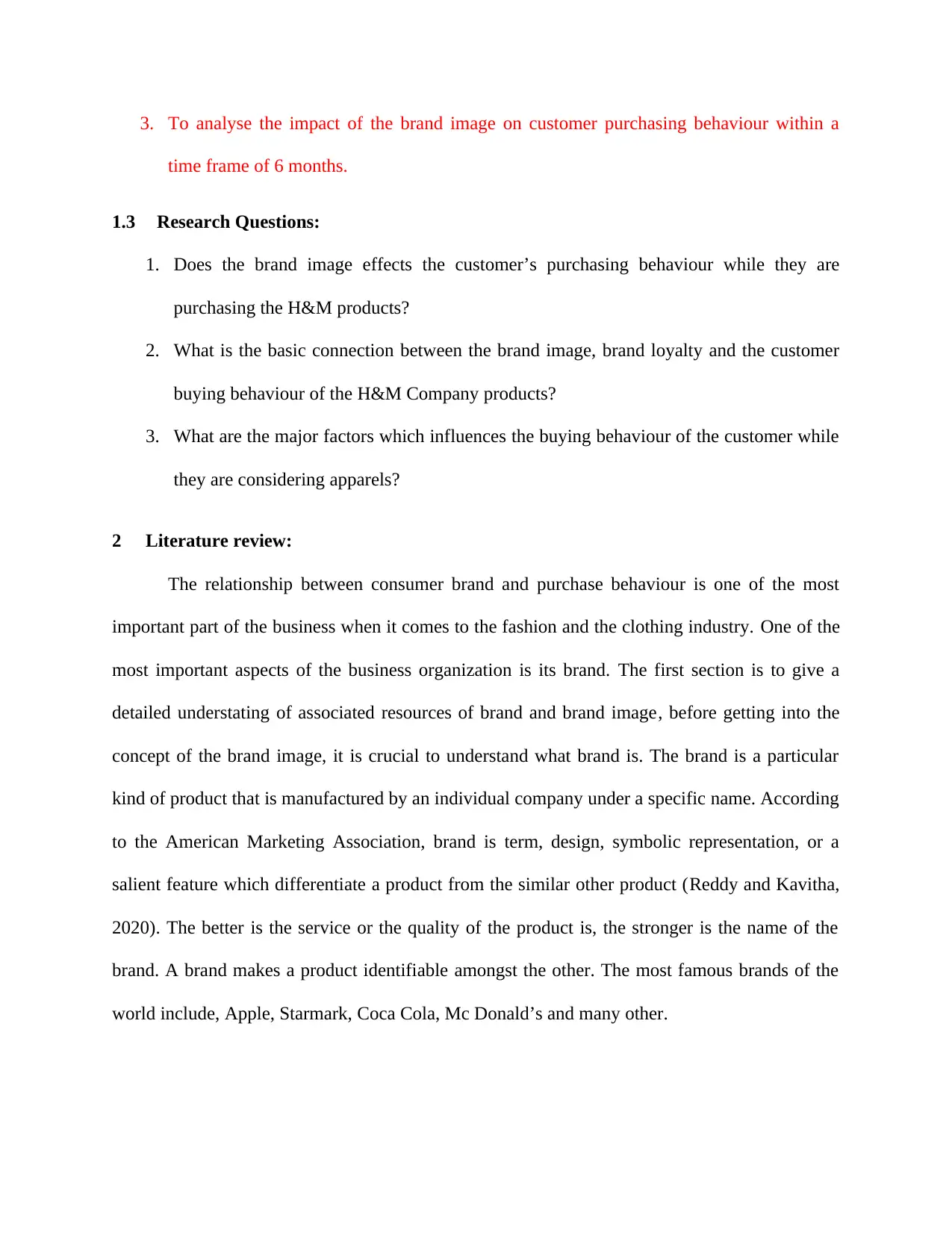
3. To analyse the impact of the brand image on customer purchasing behaviour within a
time frame of 6 months.
1.3 Research Questions:
1. Does the brand image effects the customer’s purchasing behaviour while they are
purchasing the H&M products?
2. What is the basic connection between the brand image, brand loyalty and the customer
buying behaviour of the H&M Company products?
3. What are the major factors which influences the buying behaviour of the customer while
they are considering apparels?
2 Literature review:
The relationship between consumer brand and purchase behaviour is one of the most
important part of the business when it comes to the fashion and the clothing industry. One of the
most important aspects of the business organization is its brand. The first section is to give a
detailed understating of associated resources of brand and brand image, before getting into the
concept of the brand image, it is crucial to understand what brand is. The brand is a particular
kind of product that is manufactured by an individual company under a specific name. According
to the American Marketing Association, brand is term, design, symbolic representation, or a
salient feature which differentiate a product from the similar other product (Reddy and Kavitha,
2020). The better is the service or the quality of the product is, the stronger is the name of the
brand. A brand makes a product identifiable amongst the other. The most famous brands of the
world include, Apple, Starmark, Coca Cola, Mc Donald’s and many other.
time frame of 6 months.
1.3 Research Questions:
1. Does the brand image effects the customer’s purchasing behaviour while they are
purchasing the H&M products?
2. What is the basic connection between the brand image, brand loyalty and the customer
buying behaviour of the H&M Company products?
3. What are the major factors which influences the buying behaviour of the customer while
they are considering apparels?
2 Literature review:
The relationship between consumer brand and purchase behaviour is one of the most
important part of the business when it comes to the fashion and the clothing industry. One of the
most important aspects of the business organization is its brand. The first section is to give a
detailed understating of associated resources of brand and brand image, before getting into the
concept of the brand image, it is crucial to understand what brand is. The brand is a particular
kind of product that is manufactured by an individual company under a specific name. According
to the American Marketing Association, brand is term, design, symbolic representation, or a
salient feature which differentiate a product from the similar other product (Reddy and Kavitha,
2020). The better is the service or the quality of the product is, the stronger is the name of the
brand. A brand makes a product identifiable amongst the other. The most famous brands of the
world include, Apple, Starmark, Coca Cola, Mc Donald’s and many other.
Paraphrase This Document
Need a fresh take? Get an instant paraphrase of this document with our AI Paraphraser
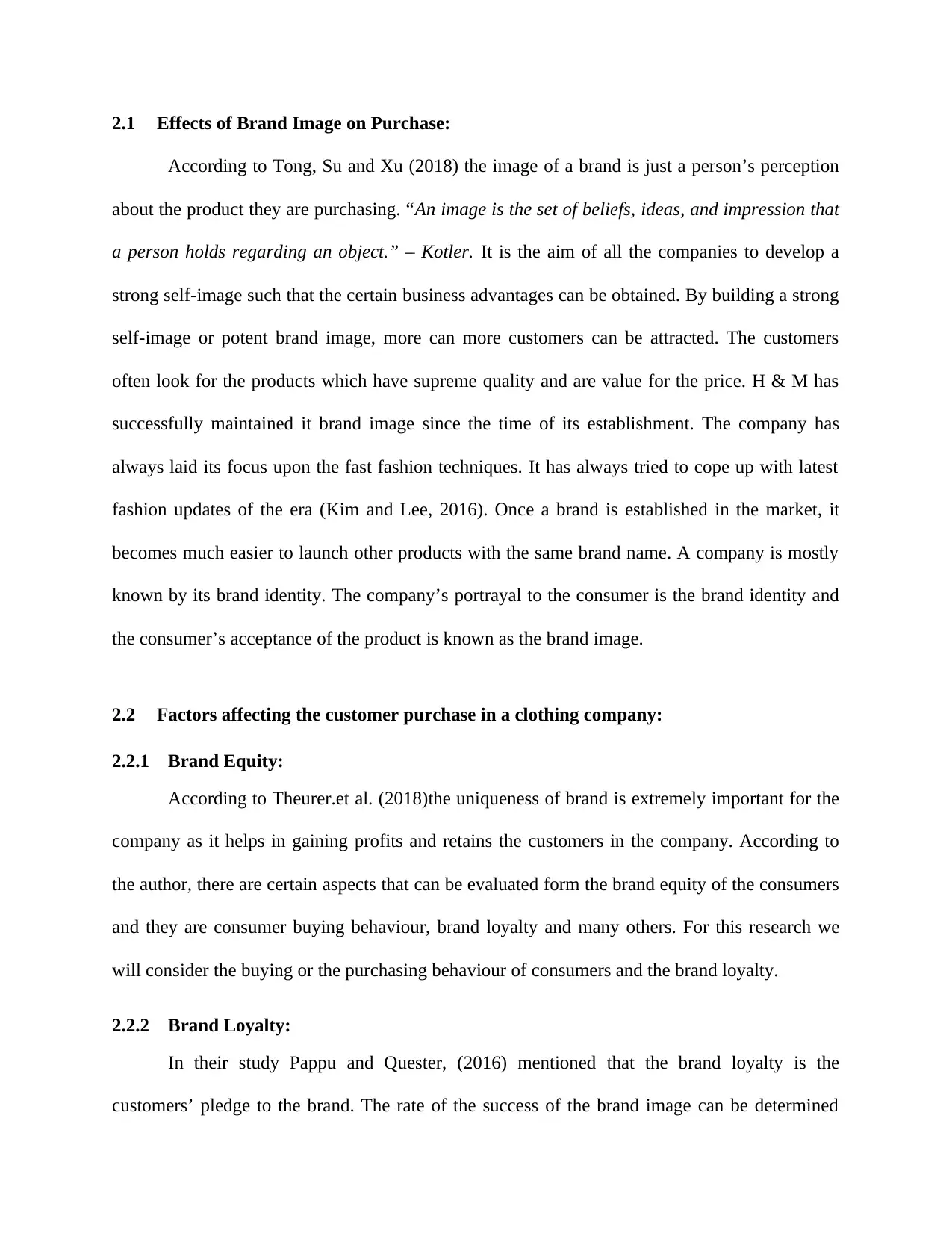
2.1 Effects of Brand Image on Purchase:
According to Tong, Su and Xu (2018) the image of a brand is just a person’s perception
about the product they are purchasing. “An image is the set of beliefs, ideas, and impression that
a person holds regarding an object.” – Kotler. It is the aim of all the companies to develop a
strong self-image such that the certain business advantages can be obtained. By building a strong
self-image or potent brand image, more can more customers can be attracted. The customers
often look for the products which have supreme quality and are value for the price. H & M has
successfully maintained it brand image since the time of its establishment. The company has
always laid its focus upon the fast fashion techniques. It has always tried to cope up with latest
fashion updates of the era (Kim and Lee, 2016). Once a brand is established in the market, it
becomes much easier to launch other products with the same brand name. A company is mostly
known by its brand identity. The company’s portrayal to the consumer is the brand identity and
the consumer’s acceptance of the product is known as the brand image.
2.2 Factors affecting the customer purchase in a clothing company:
2.2.1 Brand Equity:
According to Theurer.et al. (2018)the uniqueness of brand is extremely important for the
company as it helps in gaining profits and retains the customers in the company. According to
the author, there are certain aspects that can be evaluated form the brand equity of the consumers
and they are consumer buying behaviour, brand loyalty and many others. For this research we
will consider the buying or the purchasing behaviour of consumers and the brand loyalty.
2.2.2 Brand Loyalty:
In their study Pappu and Quester, (2016) mentioned that the brand loyalty is the
customers’ pledge to the brand. The rate of the success of the brand image can be determined
According to Tong, Su and Xu (2018) the image of a brand is just a person’s perception
about the product they are purchasing. “An image is the set of beliefs, ideas, and impression that
a person holds regarding an object.” – Kotler. It is the aim of all the companies to develop a
strong self-image such that the certain business advantages can be obtained. By building a strong
self-image or potent brand image, more can more customers can be attracted. The customers
often look for the products which have supreme quality and are value for the price. H & M has
successfully maintained it brand image since the time of its establishment. The company has
always laid its focus upon the fast fashion techniques. It has always tried to cope up with latest
fashion updates of the era (Kim and Lee, 2016). Once a brand is established in the market, it
becomes much easier to launch other products with the same brand name. A company is mostly
known by its brand identity. The company’s portrayal to the consumer is the brand identity and
the consumer’s acceptance of the product is known as the brand image.
2.2 Factors affecting the customer purchase in a clothing company:
2.2.1 Brand Equity:
According to Theurer.et al. (2018)the uniqueness of brand is extremely important for the
company as it helps in gaining profits and retains the customers in the company. According to
the author, there are certain aspects that can be evaluated form the brand equity of the consumers
and they are consumer buying behaviour, brand loyalty and many others. For this research we
will consider the buying or the purchasing behaviour of consumers and the brand loyalty.
2.2.2 Brand Loyalty:
In their study Pappu and Quester, (2016) mentioned that the brand loyalty is the
customers’ pledge to the brand. The rate of the success of the brand image can be determined

from the brand loyalty. As mentioned earlier, the increase in the rate of the brand loyalty is the
reward for the company. The brand loyalty is the preference if the consumer towards the same
brand due to its products and services. Wilson in 1995 said “Loyalty is also interpreted as an
expectation to continue a relationship with a particular brand”. According to Wilson and Persson,
(2017) the brand loyalty can be expected from two types of the customers, and they are driven by
five most important factors - Emotional connection, superiority, dependability, and social media.
In order to establish a stronger brand image, the companies has to maintain the image of
consistency amongst its consumers. The ultimate aim of the organisations are to retain customer
such that they keep on coming back. This increases their profit which helps in setting up new
budgets (Haryanto, Moutinho and Coelho 2016).
2.3 Impact of brand image on Customer buying behaviour:
The purchase behaviour of the customer is the effort taken by the consumer for buying a
particular service or a product. One of the best ways of identifying the purchasing behaviour of
the consumer is to observe the pattern of the purchase (Tahir and Ali 2018). The consumers can
be divided into certain categories depending upon their buying pattern. Customer based brand
equity or CBBE was conceptualized in the year 1933 by Keller. This referred to various reactions
from the consumers having knowledge of unique brands in varying degrees. Thus, it can be said
that brand equity can be generated with the help of brand imageand brand awareness. According
to Keller and Brexendorf, (2019) customer satisfaction is the prime source of brand image.
Testing the shopping experience of the consumers in H&M Company, it is seen that performance
specific expectations of customers along with disconfirmation of expectations are the major
indicators of satisfaction for customers (Tarmedi et al. 2018).
reward for the company. The brand loyalty is the preference if the consumer towards the same
brand due to its products and services. Wilson in 1995 said “Loyalty is also interpreted as an
expectation to continue a relationship with a particular brand”. According to Wilson and Persson,
(2017) the brand loyalty can be expected from two types of the customers, and they are driven by
five most important factors - Emotional connection, superiority, dependability, and social media.
In order to establish a stronger brand image, the companies has to maintain the image of
consistency amongst its consumers. The ultimate aim of the organisations are to retain customer
such that they keep on coming back. This increases their profit which helps in setting up new
budgets (Haryanto, Moutinho and Coelho 2016).
2.3 Impact of brand image on Customer buying behaviour:
The purchase behaviour of the customer is the effort taken by the consumer for buying a
particular service or a product. One of the best ways of identifying the purchasing behaviour of
the consumer is to observe the pattern of the purchase (Tahir and Ali 2018). The consumers can
be divided into certain categories depending upon their buying pattern. Customer based brand
equity or CBBE was conceptualized in the year 1933 by Keller. This referred to various reactions
from the consumers having knowledge of unique brands in varying degrees. Thus, it can be said
that brand equity can be generated with the help of brand imageand brand awareness. According
to Keller and Brexendorf, (2019) customer satisfaction is the prime source of brand image.
Testing the shopping experience of the consumers in H&M Company, it is seen that performance
specific expectations of customers along with disconfirmation of expectations are the major
indicators of satisfaction for customers (Tarmedi et al. 2018).
⊘ This is a preview!⊘
Do you want full access?
Subscribe today to unlock all pages.

Trusted by 1+ million students worldwide
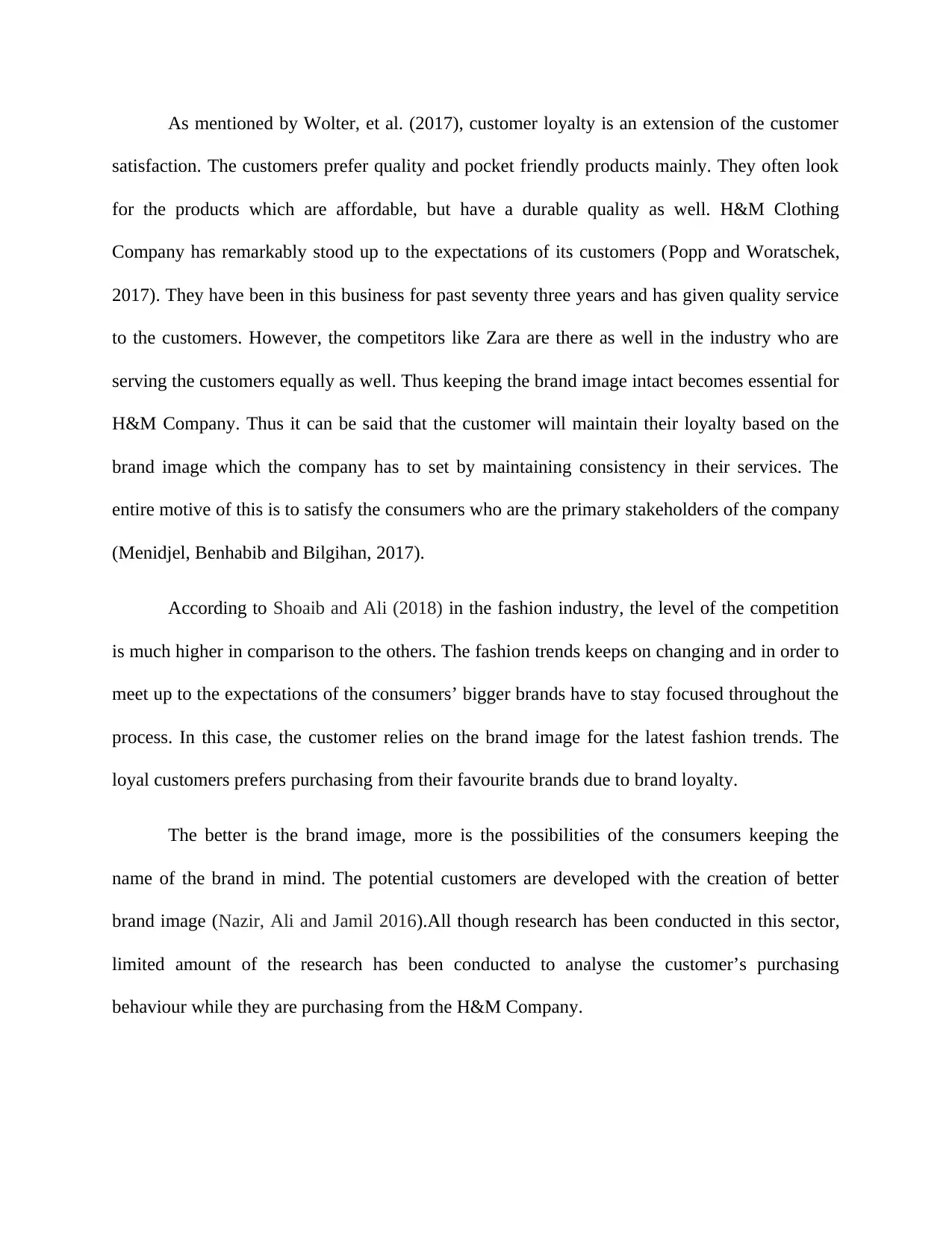
As mentioned by Wolter, et al. (2017), customer loyalty is an extension of the customer
satisfaction. The customers prefer quality and pocket friendly products mainly. They often look
for the products which are affordable, but have a durable quality as well. H&M Clothing
Company has remarkably stood up to the expectations of its customers (Popp and Woratschek,
2017). They have been in this business for past seventy three years and has given quality service
to the customers. However, the competitors like Zara are there as well in the industry who are
serving the customers equally as well. Thus keeping the brand image intact becomes essential for
H&M Company. Thus it can be said that the customer will maintain their loyalty based on the
brand image which the company has to set by maintaining consistency in their services. The
entire motive of this is to satisfy the consumers who are the primary stakeholders of the company
(Menidjel, Benhabib and Bilgihan, 2017).
According to Shoaib and Ali (2018) in the fashion industry, the level of the competition
is much higher in comparison to the others. The fashion trends keeps on changing and in order to
meet up to the expectations of the consumers’ bigger brands have to stay focused throughout the
process. In this case, the customer relies on the brand image for the latest fashion trends. The
loyal customers prefers purchasing from their favourite brands due to brand loyalty.
The better is the brand image, more is the possibilities of the consumers keeping the
name of the brand in mind. The potential customers are developed with the creation of better
brand image (Nazir, Ali and Jamil 2016).All though research has been conducted in this sector,
limited amount of the research has been conducted to analyse the customer’s purchasing
behaviour while they are purchasing from the H&M Company.
satisfaction. The customers prefer quality and pocket friendly products mainly. They often look
for the products which are affordable, but have a durable quality as well. H&M Clothing
Company has remarkably stood up to the expectations of its customers (Popp and Woratschek,
2017). They have been in this business for past seventy three years and has given quality service
to the customers. However, the competitors like Zara are there as well in the industry who are
serving the customers equally as well. Thus keeping the brand image intact becomes essential for
H&M Company. Thus it can be said that the customer will maintain their loyalty based on the
brand image which the company has to set by maintaining consistency in their services. The
entire motive of this is to satisfy the consumers who are the primary stakeholders of the company
(Menidjel, Benhabib and Bilgihan, 2017).
According to Shoaib and Ali (2018) in the fashion industry, the level of the competition
is much higher in comparison to the others. The fashion trends keeps on changing and in order to
meet up to the expectations of the consumers’ bigger brands have to stay focused throughout the
process. In this case, the customer relies on the brand image for the latest fashion trends. The
loyal customers prefers purchasing from their favourite brands due to brand loyalty.
The better is the brand image, more is the possibilities of the consumers keeping the
name of the brand in mind. The potential customers are developed with the creation of better
brand image (Nazir, Ali and Jamil 2016).All though research has been conducted in this sector,
limited amount of the research has been conducted to analyse the customer’s purchasing
behaviour while they are purchasing from the H&M Company.
Paraphrase This Document
Need a fresh take? Get an instant paraphrase of this document with our AI Paraphraser
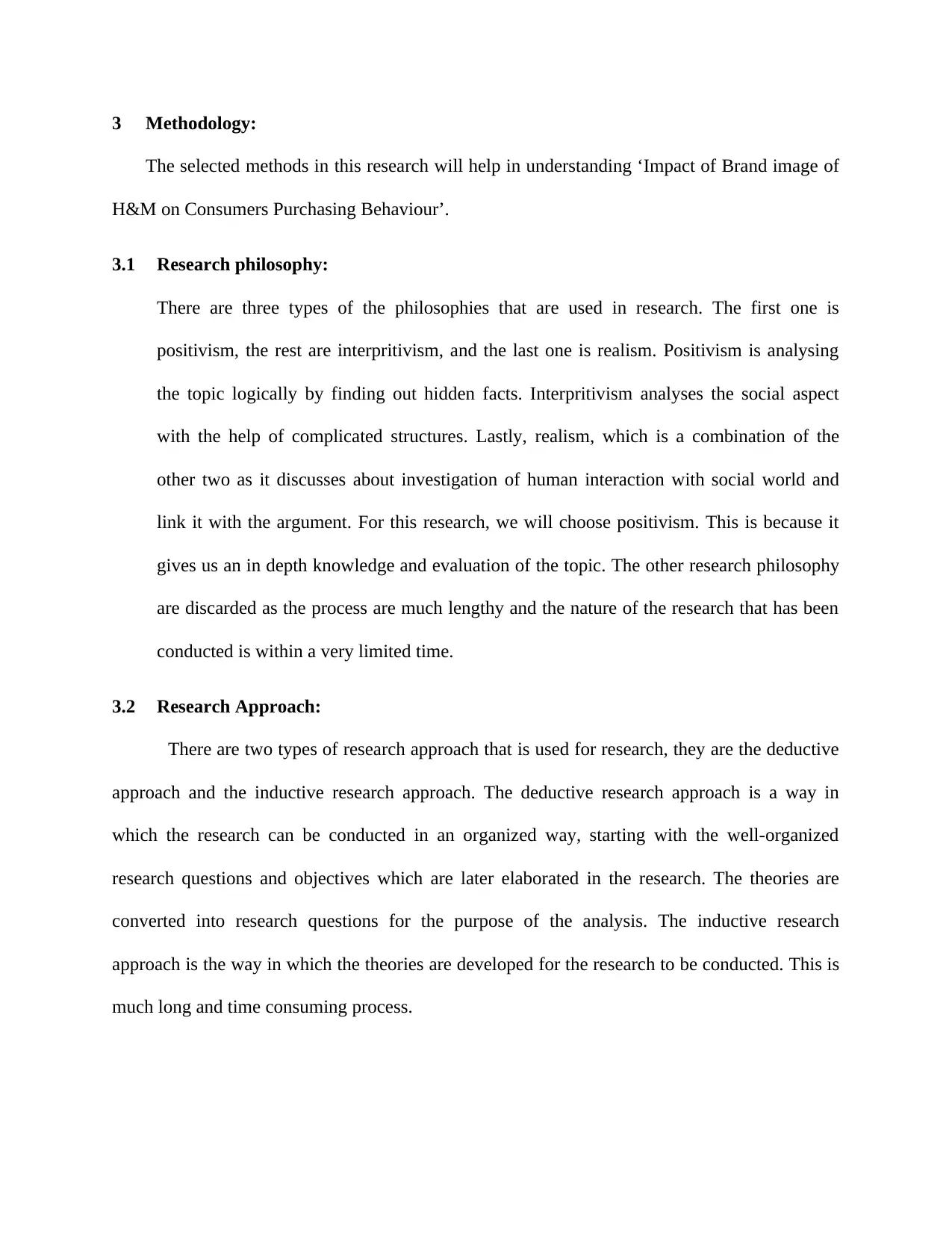
3 Methodology:
The selected methods in this research will help in understanding ‘Impact of Brand image of
H&M on Consumers Purchasing Behaviour’.
3.1 Research philosophy:
There are three types of the philosophies that are used in research. The first one is
positivism, the rest are interpritivism, and the last one is realism. Positivism is analysing
the topic logically by finding out hidden facts. Interpritivism analyses the social aspect
with the help of complicated structures. Lastly, realism, which is a combination of the
other two as it discusses about investigation of human interaction with social world and
link it with the argument. For this research, we will choose positivism. This is because it
gives us an in depth knowledge and evaluation of the topic. The other research philosophy
are discarded as the process are much lengthy and the nature of the research that has been
conducted is within a very limited time.
3.2 Research Approach:
There are two types of research approach that is used for research, they are the deductive
approach and the inductive research approach. The deductive research approach is a way in
which the research can be conducted in an organized way, starting with the well-organized
research questions and objectives which are later elaborated in the research. The theories are
converted into research questions for the purpose of the analysis. The inductive research
approach is the way in which the theories are developed for the research to be conducted. This is
much long and time consuming process.
The selected methods in this research will help in understanding ‘Impact of Brand image of
H&M on Consumers Purchasing Behaviour’.
3.1 Research philosophy:
There are three types of the philosophies that are used in research. The first one is
positivism, the rest are interpritivism, and the last one is realism. Positivism is analysing
the topic logically by finding out hidden facts. Interpritivism analyses the social aspect
with the help of complicated structures. Lastly, realism, which is a combination of the
other two as it discusses about investigation of human interaction with social world and
link it with the argument. For this research, we will choose positivism. This is because it
gives us an in depth knowledge and evaluation of the topic. The other research philosophy
are discarded as the process are much lengthy and the nature of the research that has been
conducted is within a very limited time.
3.2 Research Approach:
There are two types of research approach that is used for research, they are the deductive
approach and the inductive research approach. The deductive research approach is a way in
which the research can be conducted in an organized way, starting with the well-organized
research questions and objectives which are later elaborated in the research. The theories are
converted into research questions for the purpose of the analysis. The inductive research
approach is the way in which the theories are developed for the research to be conducted. This is
much long and time consuming process.
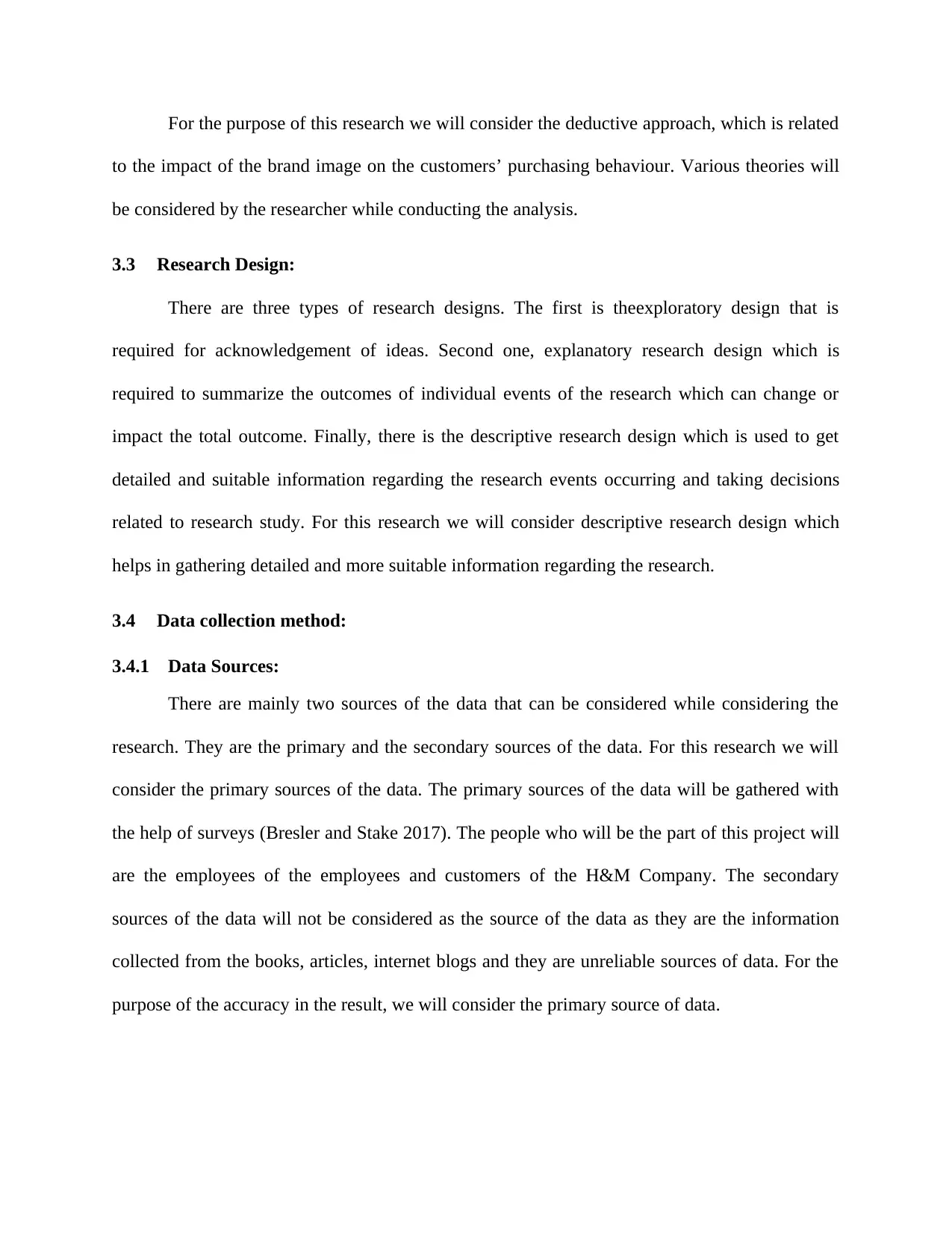
For the purpose of this research we will consider the deductive approach, which is related
to the impact of the brand image on the customers’ purchasing behaviour. Various theories will
be considered by the researcher while conducting the analysis.
3.3 Research Design:
There are three types of research designs. The first is theexploratory design that is
required for acknowledgement of ideas. Second one, explanatory research design which is
required to summarize the outcomes of individual events of the research which can change or
impact the total outcome. Finally, there is the descriptive research design which is used to get
detailed and suitable information regarding the research events occurring and taking decisions
related to research study. For this research we will consider descriptive research design which
helps in gathering detailed and more suitable information regarding the research.
3.4 Data collection method:
3.4.1 Data Sources:
There are mainly two sources of the data that can be considered while considering the
research. They are the primary and the secondary sources of the data. For this research we will
consider the primary sources of the data. The primary sources of the data will be gathered with
the help of surveys (Bresler and Stake 2017). The people who will be the part of this project will
are the employees of the employees and customers of the H&M Company. The secondary
sources of the data will not be considered as the source of the data as they are the information
collected from the books, articles, internet blogs and they are unreliable sources of data. For the
purpose of the accuracy in the result, we will consider the primary source of data.
to the impact of the brand image on the customers’ purchasing behaviour. Various theories will
be considered by the researcher while conducting the analysis.
3.3 Research Design:
There are three types of research designs. The first is theexploratory design that is
required for acknowledgement of ideas. Second one, explanatory research design which is
required to summarize the outcomes of individual events of the research which can change or
impact the total outcome. Finally, there is the descriptive research design which is used to get
detailed and suitable information regarding the research events occurring and taking decisions
related to research study. For this research we will consider descriptive research design which
helps in gathering detailed and more suitable information regarding the research.
3.4 Data collection method:
3.4.1 Data Sources:
There are mainly two sources of the data that can be considered while considering the
research. They are the primary and the secondary sources of the data. For this research we will
consider the primary sources of the data. The primary sources of the data will be gathered with
the help of surveys (Bresler and Stake 2017). The people who will be the part of this project will
are the employees of the employees and customers of the H&M Company. The secondary
sources of the data will not be considered as the source of the data as they are the information
collected from the books, articles, internet blogs and they are unreliable sources of data. For the
purpose of the accuracy in the result, we will consider the primary source of data.
⊘ This is a preview!⊘
Do you want full access?
Subscribe today to unlock all pages.

Trusted by 1+ million students worldwide

3.4.2 Analysis of the data:
For this research we will choose the Quantitative analysis of the data among the
Qualitative and Quantitative methods for the analysis of the data (Mohajan 2018). The
Quantitative Analysis of the data is numerical approach of analysing the data that is gathered
from the survey. The response generated by the survey can be used for finding the regression
(Kumar 2019). The Qualitative data analysis of the data is the theoretical approach which is a
much simpler process, but due to less accuracy in the analysis of the data we will discard this
process if the data analysis.
3.4.3 Sample Size:
The population size considered for this research is 100. For attaining the accuracy in the
analysis of the data we will consider 10 people with the help of simple random sampling
technique.For example, in a company consisting of 250 employees, 25 employees can be
considered for the purpose of the survey. Their responses will be considered randomly and data
analysis will be conducted. In this method all the population will be provided with equal
opportunity in the sample size.
For this research we will choose the Quantitative analysis of the data among the
Qualitative and Quantitative methods for the analysis of the data (Mohajan 2018). The
Quantitative Analysis of the data is numerical approach of analysing the data that is gathered
from the survey. The response generated by the survey can be used for finding the regression
(Kumar 2019). The Qualitative data analysis of the data is the theoretical approach which is a
much simpler process, but due to less accuracy in the analysis of the data we will discard this
process if the data analysis.
3.4.3 Sample Size:
The population size considered for this research is 100. For attaining the accuracy in the
analysis of the data we will consider 10 people with the help of simple random sampling
technique.For example, in a company consisting of 250 employees, 25 employees can be
considered for the purpose of the survey. Their responses will be considered randomly and data
analysis will be conducted. In this method all the population will be provided with equal
opportunity in the sample size.
Paraphrase This Document
Need a fresh take? Get an instant paraphrase of this document with our AI Paraphraser
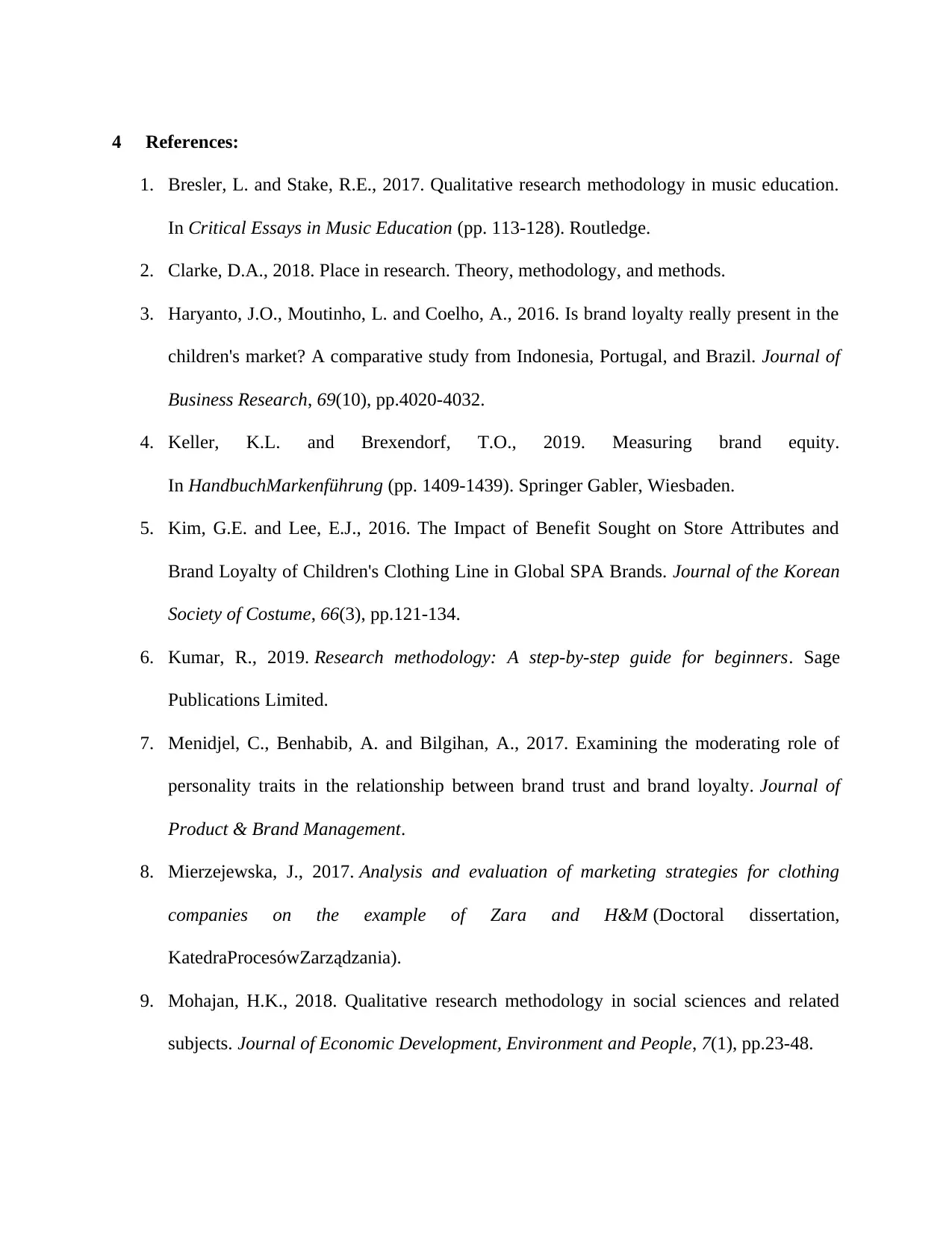
4 References:
1. Bresler, L. and Stake, R.E., 2017. Qualitative research methodology in music education.
In Critical Essays in Music Education (pp. 113-128). Routledge.
2. Clarke, D.A., 2018. Place in research. Theory, methodology, and methods.
3. Haryanto, J.O., Moutinho, L. and Coelho, A., 2016. Is brand loyalty really present in the
children's market? A comparative study from Indonesia, Portugal, and Brazil. Journal of
Business Research, 69(10), pp.4020-4032.
4. Keller, K.L. and Brexendorf, T.O., 2019. Measuring brand equity.
In HandbuchMarkenführung (pp. 1409-1439). Springer Gabler, Wiesbaden.
5. Kim, G.E. and Lee, E.J., 2016. The Impact of Benefit Sought on Store Attributes and
Brand Loyalty of Children's Clothing Line in Global SPA Brands. Journal of the Korean
Society of Costume, 66(3), pp.121-134.
6. Kumar, R., 2019. Research methodology: A step-by-step guide for beginners. Sage
Publications Limited.
7. Menidjel, C., Benhabib, A. and Bilgihan, A., 2017. Examining the moderating role of
personality traits in the relationship between brand trust and brand loyalty. Journal of
Product & Brand Management.
8. Mierzejewska, J., 2017. Analysis and evaluation of marketing strategies for clothing
companies on the example of Zara and H&M (Doctoral dissertation,
KatedraProcesówZarządzania).
9. Mohajan, H.K., 2018. Qualitative research methodology in social sciences and related
subjects. Journal of Economic Development, Environment and People, 7(1), pp.23-48.
1. Bresler, L. and Stake, R.E., 2017. Qualitative research methodology in music education.
In Critical Essays in Music Education (pp. 113-128). Routledge.
2. Clarke, D.A., 2018. Place in research. Theory, methodology, and methods.
3. Haryanto, J.O., Moutinho, L. and Coelho, A., 2016. Is brand loyalty really present in the
children's market? A comparative study from Indonesia, Portugal, and Brazil. Journal of
Business Research, 69(10), pp.4020-4032.
4. Keller, K.L. and Brexendorf, T.O., 2019. Measuring brand equity.
In HandbuchMarkenführung (pp. 1409-1439). Springer Gabler, Wiesbaden.
5. Kim, G.E. and Lee, E.J., 2016. The Impact of Benefit Sought on Store Attributes and
Brand Loyalty of Children's Clothing Line in Global SPA Brands. Journal of the Korean
Society of Costume, 66(3), pp.121-134.
6. Kumar, R., 2019. Research methodology: A step-by-step guide for beginners. Sage
Publications Limited.
7. Menidjel, C., Benhabib, A. and Bilgihan, A., 2017. Examining the moderating role of
personality traits in the relationship between brand trust and brand loyalty. Journal of
Product & Brand Management.
8. Mierzejewska, J., 2017. Analysis and evaluation of marketing strategies for clothing
companies on the example of Zara and H&M (Doctoral dissertation,
KatedraProcesówZarządzania).
9. Mohajan, H.K., 2018. Qualitative research methodology in social sciences and related
subjects. Journal of Economic Development, Environment and People, 7(1), pp.23-48.
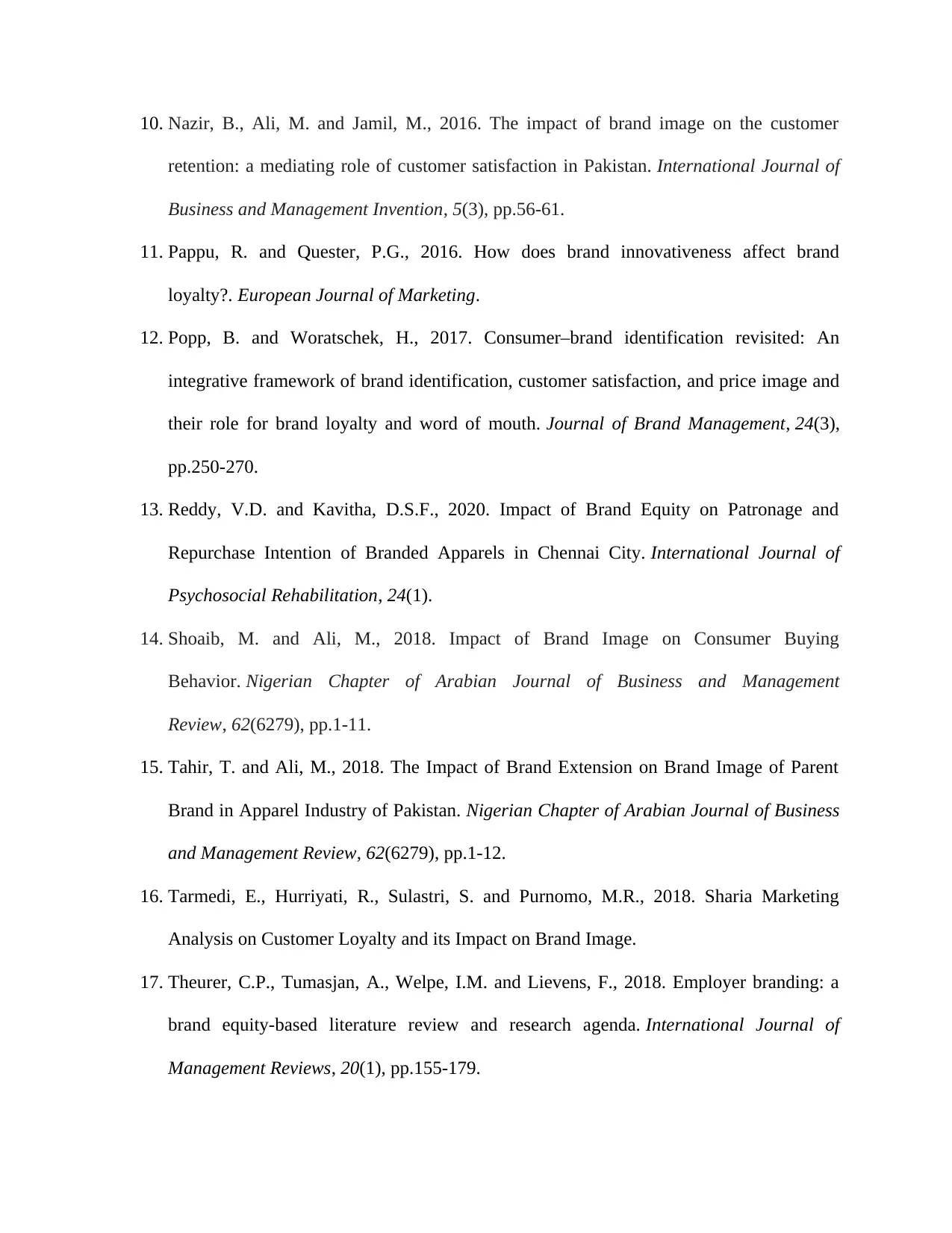
10. Nazir, B., Ali, M. and Jamil, M., 2016. The impact of brand image on the customer
retention: a mediating role of customer satisfaction in Pakistan. International Journal of
Business and Management Invention, 5(3), pp.56-61.
11. Pappu, R. and Quester, P.G., 2016. How does brand innovativeness affect brand
loyalty?. European Journal of Marketing.
12. Popp, B. and Woratschek, H., 2017. Consumer–brand identification revisited: An
integrative framework of brand identification, customer satisfaction, and price image and
their role for brand loyalty and word of mouth. Journal of Brand Management, 24(3),
pp.250-270.
13. Reddy, V.D. and Kavitha, D.S.F., 2020. Impact of Brand Equity on Patronage and
Repurchase Intention of Branded Apparels in Chennai City. International Journal of
Psychosocial Rehabilitation, 24(1).
14. Shoaib, M. and Ali, M., 2018. Impact of Brand Image on Consumer Buying
Behavior. Nigerian Chapter of Arabian Journal of Business and Management
Review, 62(6279), pp.1-11.
15. Tahir, T. and Ali, M., 2018. The Impact of Brand Extension on Brand Image of Parent
Brand in Apparel Industry of Pakistan. Nigerian Chapter of Arabian Journal of Business
and Management Review, 62(6279), pp.1-12.
16. Tarmedi, E., Hurriyati, R., Sulastri, S. and Purnomo, M.R., 2018. Sharia Marketing
Analysis on Customer Loyalty and its Impact on Brand Image.
17. Theurer, C.P., Tumasjan, A., Welpe, I.M. and Lievens, F., 2018. Employer branding: a
brand equity‐based literature review and research agenda. International Journal of
Management Reviews, 20(1), pp.155-179.
retention: a mediating role of customer satisfaction in Pakistan. International Journal of
Business and Management Invention, 5(3), pp.56-61.
11. Pappu, R. and Quester, P.G., 2016. How does brand innovativeness affect brand
loyalty?. European Journal of Marketing.
12. Popp, B. and Woratschek, H., 2017. Consumer–brand identification revisited: An
integrative framework of brand identification, customer satisfaction, and price image and
their role for brand loyalty and word of mouth. Journal of Brand Management, 24(3),
pp.250-270.
13. Reddy, V.D. and Kavitha, D.S.F., 2020. Impact of Brand Equity on Patronage and
Repurchase Intention of Branded Apparels in Chennai City. International Journal of
Psychosocial Rehabilitation, 24(1).
14. Shoaib, M. and Ali, M., 2018. Impact of Brand Image on Consumer Buying
Behavior. Nigerian Chapter of Arabian Journal of Business and Management
Review, 62(6279), pp.1-11.
15. Tahir, T. and Ali, M., 2018. The Impact of Brand Extension on Brand Image of Parent
Brand in Apparel Industry of Pakistan. Nigerian Chapter of Arabian Journal of Business
and Management Review, 62(6279), pp.1-12.
16. Tarmedi, E., Hurriyati, R., Sulastri, S. and Purnomo, M.R., 2018. Sharia Marketing
Analysis on Customer Loyalty and its Impact on Brand Image.
17. Theurer, C.P., Tumasjan, A., Welpe, I.M. and Lievens, F., 2018. Employer branding: a
brand equity‐based literature review and research agenda. International Journal of
Management Reviews, 20(1), pp.155-179.
⊘ This is a preview!⊘
Do you want full access?
Subscribe today to unlock all pages.

Trusted by 1+ million students worldwide
1 out of 13
Related Documents
Your All-in-One AI-Powered Toolkit for Academic Success.
+13062052269
info@desklib.com
Available 24*7 on WhatsApp / Email
![[object Object]](/_next/static/media/star-bottom.7253800d.svg)
Unlock your academic potential
Copyright © 2020–2025 A2Z Services. All Rights Reserved. Developed and managed by ZUCOL.





